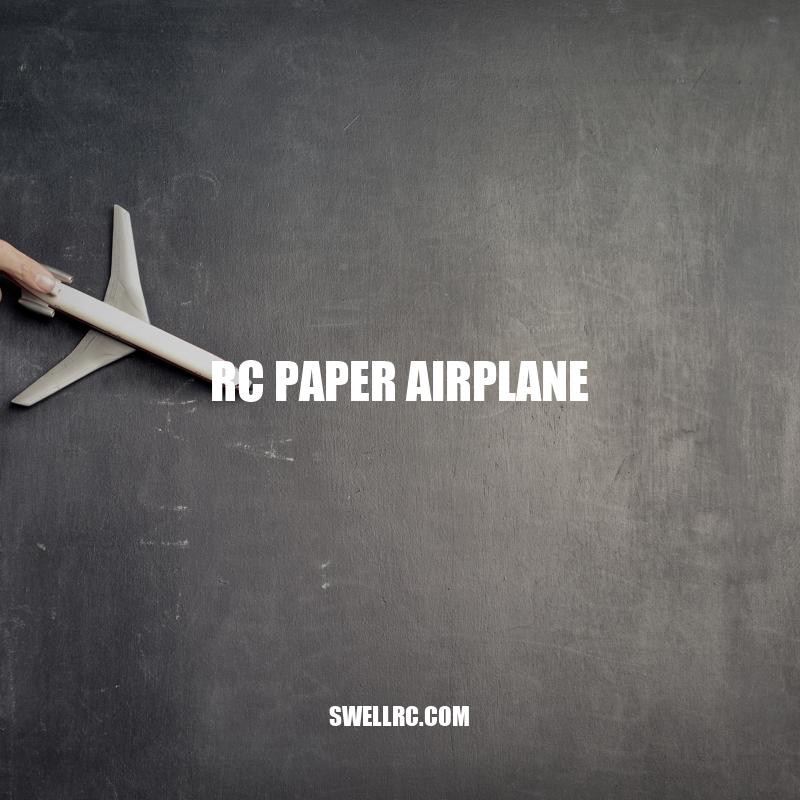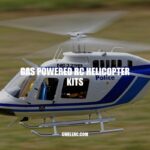Mastering the Art of RC Paper Airplanes: A Beginner’s Guide
Paper airplanes have been a timeless classic for generations, but what if you could take it one step further? With RC paper airplanes, you can! RC paper airplanes are essentially remote-controlled planes made out of foam or balsa wood that allow you to control it’s flight trajectory and speed for a more immersive experience. Building and flying RC paper airplanes is not only a fun and thrilling activity, but it can also provide an opportunity to learn about electronics, physics, and aerodynamics, giving you a better understanding of how things fly. Furthermore, it’s a great way to bond with friends and family, and foster a love for aviation and engineering. In this article, we’ll guide you through the process of building your own RC paper airplane, including the materials and tools needed, building process, testing and tweaking, safety precautions, flying techniques, and tricks. So get ready to take to the skies with your very own custom-built RC paper airplane!
Materials and Tools Needed
RC paper airplanes require a bit more specialized equipment and materials than traditional paper airplanes. Some of the materials and tools required include:
- Foam or balsa wood
- Glue
- Electronic components, such as motors, servos, and battery packs
It’s important to choose high-quality materials, as this can impact the longevity and flight performance of your airplane. As for tools, you’ll need:
- Hobby knife
- Sander
- Digital scale
These tools will allow you to precision-cut your materials, sand down rough edges, and measure the weight distribution of your airplane. Many hobby shops and online stores sell RC airplane kits that include all the necessary materials and tools for building your own RC paper airplane.
What are the requirements for a paper airplane?
To build a paper airplane, you don’t need much more than just a single sheet of paper. However, there are a few requirements that should be met if you want your paper airplane to perform well:
- Use lightweight paper as it makes the airplane easier to fly.
- Ensure the paper is rectangular and not square as rectangular paper makes better wings.
- Make creases sharp and precise. This will help the plane maintain its shape and prevent it from crashing quickly.
- Hold and throw the plane correctly to help it fly better.
These are just the basic requirements for making a simple paper airplane. However, advanced builders can also use different types of paper, gluing techniques, and even add decorations to their paper airplanes.
If you’re looking for more information on building paper airplanes, there are many websites and books available that offer instructions, designs, and tips for making different types of paper airplanes. Some popular resources include Fold ‘N Fly, The Paper Airplane Guy, and The New World Champion Paper Airplane Book.
Building the RC Paper Airplane
Building an RC paper airplane is a fun project that requires patience, attention to detail and some technical skills. Here are a few steps to build your own RC paper airplane:
- Step 1: Choose a design. There are several RC paper airplane designs available online and in kits, so choose one that fits your skill level.
- Step 2: Cut out the foam or balsa wood parts. Use a hobby knife and a cutting mat to create precise cuts.
- Step 3: Assemble the electronics. Follow the instructions included with your electronics kit, and make sure the motors and other components are securely attached to the foam or balsa wood parts.
- Step 4: Install servos. Servos are small motors that control the movement of the airplane’s control surfaces. Make sure to align the servos correctly with the control surfaces to ensure proper movement.
- Step 5: Connect the electronics. Connect the battery pack and receiver to the servos and motors, and test your connections before flying.
Remember that building an RC paper airplane requires precision and lots of attention to detail. You may need to make adjustments to the weight distribution or angle of certain components to get the airplane to fly smoothly. Here is a table that compares foam and balsa wood as materials for your RC paper airplane:
| Material | Advantages | Disadvantages |
|---|---|---|
| Foam | Lightweight, easy to cut and shape, durable, affordable, readily available | May not provide as smooth a flight as balsa wood, more difficult to sand and shape to specific designs, surface can become wrinkled or dented over time |
| Balsa Wood | Extremely lightweight, very durable, can handle more complex designs, can be sanded down smoothly for a more aerodynamic design | Much more expensive than foam, can be more difficult to find, not as forgiving to beginners who may make mistakes during the building process |
When it comes to RC paper airplane kits, there are several brands that make a variety of models to suit different skill levels. The E-flite brand is a popular choice among hobbyists as it offers several easy-to-build kits for beginners with pre-installed electronics. Another brand worth checking out is Motion RC, which offers a range of kits for intermediate and advanced builders with high-quality balsa wood parts.
In conclusion, building an RC paper airplane can be a rewarding and enjoyable hobby for those who have an interest in aviation and a desire to learn new skills. With patience, attention to detail and some technical knowledge, anyone can create their own high-flying masterpiece.
What materials do you need to make an RC plane?
If you’re planning to build an RC plane, you’ll need to gather a few essential items. Here are the materials you’ll need:
- Balsa wood or foam board (depending on the type of plane you want to build)
- Electric motor
- Battery
- Servo motors for controlling the plane
- Control surfaces like ailerons, rudder, and elevator
- Propeller and propeller adapter
- Radio transmitter and receiver to control the plane
- ESC (Electronic Speed Control) to control the motor speed
- Adhesives like glue, tape, or epoxy
- Tools such as a hobby knife, pliers, wire cutters, and a heat gun
You can find these materials at your local hobby store or online. There are also many RC plane kits available that include all the necessary materials. Some popular websites for RC plane materials and kits include Horizon Hobby, Tower Hobbies, and HobbyKing.
Testing and Tweaking the RC Paper Airplane
After building your RC paper airplane, it’s important to test it to make sure it flies properly. Here are a few steps to follow when testing and tweaking your airplane:
- Step 1: Find a safe location to test your airplane. Choose an open space, away from buildings, trees, or other obstacles that could damage your airplane or cause it to crash.
- Step 2: Launch your airplane at different angles. Launch your airplane at different angles, and adjust the angle each time to see how it affects the flight path.
- Step 3: Make adjustments to the balance and trim. Adjust the balance and trim on the airplane to make sure it is flying straight and evenly. Make small adjustments at a time and test after each one.
- Step 4: Consider adding weight. If your airplane is too light, it may not fly smoothly. Consider adding a small amount of weight to the front or back of the airplane to improve its stability.
There are also several resources available online to help you test and tweak your RC paper airplane. RCGroups.com is a popular forum for RC airplane enthusiasts where you can find tips and advice on building and flying RC airplanes. In addition, there are several smartphone apps available that can help you analyze and improve your airplane’s flight path, such as the RC Flight Simulator app and the AeroFly 2 app. Remember to enjoy the process and have fun while building and flying your RC paper airplane!
How do you tweak a paper airplane?
Tweaking a paper airplane can help improve its flight and make it soar higher and further. Here are some quick tips to tweak your paper airplane:
- Adjust the wings: Try angling the wings up or down to improve lift and stability
- Add weight: A heavier paper airplane can fly farther, try adding a paper clip or two
- Change the shape: Experiment with making the wings longer or shorter, or adding flaps to the tail
If you want to take your paper airplane building to the next level, there are plenty of websites and books dedicated to the craft. One popular website is Paper Airplanes HQ, which offers templates and instructions for a variety of planes, including some with advanced folds and designs.
Safety Precautions
While building and flying an RC paper airplane can be fun, it’s important to take some safety precautions to ensure you and others are safe. Here are a few tips to keep in mind:
- Tip 1: Choose a safe location to fly. Make sure you fly the airplane in an open area, away from buildings, trees, and other obstacles that could cause the airplane to crash.
- Tip 2: Always fly within your line of sight. This means you should be able to see the airplane at all times and fly it in a straight line.
- Tip 3: Follow local regulations. Make sure you are aware of local regulations that govern the use of RC airplanes and follow them.
- Tip 4: Use common sense. Avoid flying the airplane near people, animals, or buildings. Do not fly the airplane in strong winds or bad weather.
If you’re new to RC airplanes, it’s a good idea to join an online community or local club, such as the Academy of Model Aeronautics (AMA), where you can learn more about safe flying practices and connect with other enthusiasts. In addition, there are several websites and online tutorials that provide guidance on building and flying RC airplanes, such as FliteTest.com and RCPlanet.com. Remember to stay safe while enjoying this fun hobby!
What are the 3 safety precautions?
Safety precautions are crucial in preventing accidents and injuries. Here are the top three safety precautions you should always keep in mind:
- Wear protective gear – Wearing safety gear such as helmets, goggles, gloves, and respiratory masks can protect you from harm and injuries.
- Follow safety rules – Make sure to always follow safety guidelines and rules provided with any equipment or machinery.
- Maintain a clean and organized work area – A disorganized work area can lead to accidents and injuries. Keep your work area clean and organized to avoid unnecessary hazards.
Remember to follow these safety precautions to ensure a safe and secure environment. For more safety tips and guidelines, you can visit the Occupational Safety and Health Administration’s (OSHA) website at www.osha.gov.
Flying Techniques and Tricks
Flying an RC paper airplane can be a lot of fun, especially when you’re able to perform cool techniques and tricks. Here are some tips to help you get the most out of your flying experience:
- Tip 1: Launch the airplane at a slight upward angle. This will help the airplane gain altitude.
- Tip 2: Keep the airplane flying at a steady speed. This will prevent the airplane from stalling or crashing.
- Tip 3: Use a wind sock to gauge the wind direction. This will help you fly the airplane in the right direction.
- Tip 4: Experiment with different wing configurations. Changing the angle or shape of the wings can help the airplane perform different tricks.
- Tip 5: Practice performing loops and dives. These are simple but impressive tricks that are sure to impress your friends.
- Tip 6: Avoid flying in strong winds or bad weather. This can make it difficult to control the airplane and increase the risk of crashing.
There are several resources available online that can provide additional guidance on flying techniques and tricks. Websites like RCGroups.com and TheBuildingBoard.com offer forums and discussions where experienced RC airplane enthusiasts share tips and tricks. Additionally, YouTube is a great platform for watching RC airplane tutorials and seeing different techniques in action. With a little bit of practice, you’ll be able to impress your friends and family with your RC paper airplane flying skills.
How Can I Improve My Flying Skills?
Improving your flying skills can be achieved through practice and proper training. Here are some tips to help you improve:
- Take lessons with a certified flight instructor
- Practice regularly, including simulated emergency scenarios
- Learn to read aviation weather reports
- Study aircraft systems and technical knowledge
- Stay current with regulations and procedures
There are also websites and products available that can help you improve your skills, such as online flight simulators and training materials. Do your research and find what works best for you.
Conclusion
Building and flying an RC paper airplane is a fulfilling and exciting experience that can be enjoyed by people of all ages. Not only does it teach important skills like problem-solving and attention to detail, but it also provides a creative outlet for self-expression. By following the tips and techniques outlined in this article, you can build and fly an RC paper airplane that will rival even the most advanced models. Remember to always prioritize safety when flying, and never take unnecessary risks that can result in injury or damage to property.
The internet is a great resource when it comes to finding tutorials, building plans, and inspiration for your RC paper airplane projects. Online communities and forums offer a wealth of knowledge and expertise, and plenty of online stores offer parts and components you can use to build your own RC paper airplane. Whether you’re a seasoned RC plane builder or a beginner, building an RC paper airplane is a fun and worthwhile endeavor that’s sure to provide hours of entertainment.



